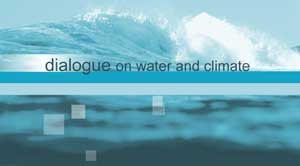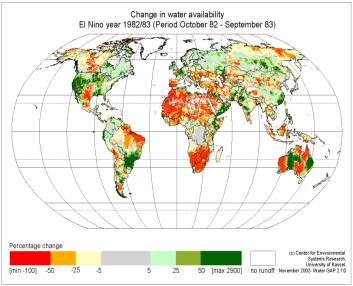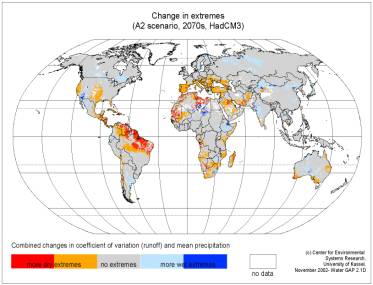Dialogue on Water and Climate (WATCLIM)
Project description IntroductionObjectives Study approach WaterGAP 2.1 |
 |
 |
 |
The Dialogue on Water and Climate was launched in December, 2001 at the Bonn Global Water Conference with the objectives to “raise awareness, develop water resources policies and capabilities, and mobilize the “will to promote” coping and adaptation strategies that reduce climate-associated vulnerability at the regional, national, and community levels.” To achieve these objectives, the organizers of the Dialogue have specified short term goals. Many of these goals have to do with the communication of information. For example, to
- draw together, maintain, and improve the required knowledge base for the Dialogue;
- provide a synthesis on key themes;
- raise awareness among key actors, through the dissemination of practical information and knowledge.
These short term goals require the dissemination of large amounts of information. In particular it is important for scientists to inform water managers (and other stakeholders of fresh water resources) about the impact of climate change on freshwater resources. The aim of this project is to support this information flow and to provide an explanation to questions such as:
- What will be the extent of climate change in river basins and countries world-wide?
- In what ways will climate change and climate variability affect river discharge.
- Will these changes be larger or smaller than the changes in water withdrawals ?
These and other questions about water and climate can be assessed on many spatial scales. Here we focus on the global scale and provide a global perspective about the issue of water and climate. In particular we identify the “hot spot” regions of the world where climate impacts on water resources are, or could become, a particular problem. Water managers are provided with basic information on water and climate (e.g. future climate and river runoff) for every basin in the world. The global-scale information
- illustrates the connection between climate change, impacts on water resources, and society’s vulnerability to these impacts on the global scale;
- shows the relevance of this connection to all river basins in the world;
- indicates that climate impacts on water resources are not only a problem within countries, but also internationally.
The specific objectives of the project are to carry out global analyses needed to provide water managers and other stakeholders with the latest information about the impact of climate on water resources. The global analyses focus especially on the impact of changing climate variability and long-term average climate change. Results of the analyses are processed into different blocks of information in the form of maps, graphics, and tabular data. These blocks of information, which are designed to be used directly in the various activities of the Dialogue, are:
- Water withdrawals in each country and river basin differentiated after the following sectors: domestic, industry (sub-sectors manufacturing and electricity), and agriculture (sub-sectors irrigation and livestock).
- Water availability for approx. 10,000 river basins covering the entire terrestrial surface of the earth outside of the ice-caps.
- Water stress and additional indicators used to estimate the condition of water resources on the river basin level (for the same number of river basins as above).
- Change in drought frequency on the river basin level.
- Maps of “hot spots” areas and “critical regions” depicting river basins particularly affected by changes in climate or withdrawals.
- Maps describing the relative susceptibility and vulnerability of countries to impacts of climate change on water resources.
- Maps to illustrate the impact of El Niño events on water availability and stress.
- An illustration of uncertainty of estimates of future impacts of climate change on water resources.
This project involves several practical steps. First, the information to be provided was discussed with the Climate and Water Dialogue Secretariat. The next step involves the preparation of the necessary inputs for the global analyses, which are performed using the WaterGAP model. This model allows the conversion of assumptions about socio-economic and climate trends into trends of water withdrawals and water availability. Third, the WaterGAP model is run using the prepared inputs, and model results are evaluated. The last step includes the presentation of results in different forms, according to the necessities of the various Dialogue activities. The main methodological approach is “scenario analysis”. Scenario analysis provides a useful tool in environmental assessments to evaluate dynamic changes in society and environment. Scenarios are defined as “hypothetical sequences of events constructed for the purpose of focusing attention on causal processes and decision points” (Kahn and Wiener, 1967). This means that scenarios can lead to possible images of the future, but these should not be interpreted as predictions or forecasts. To guarantee meaningfulness, scenarios should be based on a coherent, internally consistent, reproducible and plausible set of assumptions and/or theories of the key relationships and driving forces of change (IPCC, 2000). As mentioned above, scenario analysis is carried out with the WaterGAP model.
back
Model description (130KB, pdf)
Examples for model applications
- Critical regions: A model-based estimation of world water resources sensitive to global changes (500KB, pdf)
- Global estimates of water withdrawals and availability under current and future “business-as-usual” conditions (890KB, pdf)
Contact: floerke@usf.uni-kassel.de back